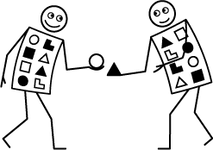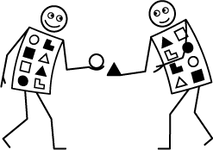What is Socionics? What is its subject? What is a metabolism? What is information?
Probably you have heard that socionics studies information metabolism. Sounds jibberish for beginners! Let's put it simpler. Metabolism is an exchange. So, Socionics deals with information exchange between someone (something). Who is this someone? Anyone who possesses mind. Once a person comes into contact with someone or something, he gets from this "someone" or "something" information. What does it mean to get in contact? Well, just look at something, touch, hear, feel the energy, in general, it is a sensory contact of any kind.What does it mean to get information? What is information? In his book "How to learn to understand people," V. D. Ermak says that "information is a metric of interaction between elements of a system." Lets try to put it in simpler words. If in the act of interaction between two objects one of them, or both are influenced in some way, then there was a transfer of information.
Let's take an example. You are looking at an apple and are getting information about it: it is green or ripe, you see its shape, you see if it has some defects, if you are an expert in apples, you could tell what sort this apple is. You have got some information about the apple. You are influenced. You can start to burn with desire to munch it, or you could probably not get such a desire. This is all a reaction to the information. You meet a person and you feel that he/she is nice to look at and this is also a reaction to the information you got about the person. You see his/her kind smile, or good looks, and the result will be your positive attitude to the person. You read in a newspaper or hear on the news that there was an earthquake somewhere. This is also information for you, even though you have never been in that place. Hence, the information can be transmitted not only directly, but also through material media (paper, magnetic tape or radio waves).
And now try to substitute in the above definition terms "system elements" with yourself and with the object you have come into contact, and the term "metric" with the term "parameter", or with the term "magnitude", and you will get the following definition:
Information is the measure (metrics) of interaction between your mind and some other object (a person, object, animal, etc.)
Information can not exist without interaction of something with another thing (or interactions of system elements). Information is arising from such an interaction. No communication - no information. There are just physical things and people instead. Imagine that at the other end of town in a room somewhere there is a chair. And you are right here, at home. You do not see, do not touch it, do not sit in that chair. You did not read or did not hear about it. Do you have interaction with it? Do you have information about this chair? Sometimes people think about the information as something that is substantial, existing independently in the outside world. Sometimes it is believed that a person can "receive" this self-existing information as a letter. But we believe that physical objects of the world contain no inherent information, they are merely physical objects. All the information arises only in our minds, as a result of our perception of various properties of things (humans, emotions, whatever).

